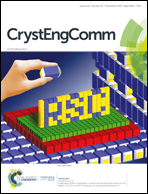Stoichiometry mechanosynthesis and interconversion of metal salts containing [CuCl3(H2O)]− and [Cu2Cl8]4−†
Abstract
Solid-state grinding plays a very important role in the study of the dynamics changes of a reaction, especially as a means of selectively preparing specific stoichiometric crystalline supramolecular complexes or cocrystals. Herein, using the tetradentate ligand (1R,2R)-N,N′-bis(pyridin-4-ylmethyl)cyclohexane-1,2-diamine (L), two copper(II) chloride salts, namely [H4L]4+·[CuCl3(H2O)]−·3Cl− (1) and [H4L]4+·[Cu2Cl8]4−·H2O (2), were produced via 1 : 1 and 1 : 2 stoichiometric controlled synthesis in a two-step process by grinding the reactants together using a mortar and pestle. By adding appropriate amounts of the corresponding components, the reversible transformation of the two salts occurred. The progress of the reversible reaction between the salt 1 and 2 was dynamically monitored by fluorescence spectroscopy, powder X-ray diffraction and Raman spectroscopy. Quantum-mechanical (QM) calculations specific for crystalline solid phases provided some insights into the relative stabilities of the two salts, indicating plausible driving forces for the reversible transformation.
![Graphical abstract: Stoichiometry mechanosynthesis and interconversion of metal salts containing [CuCl3(H2O)]− and [Cu2Cl8]4−](/en/Image/Get?imageInfo.ImageType=GA&imageInfo.ImageIdentifier.ManuscriptID=C9CE00911F&imageInfo.ImageIdentifier.Year=2019)
- This article is part of the themed collection: Editor’s Collection: Mechanochemistry


 Please wait while we load your content...
Please wait while we load your content...